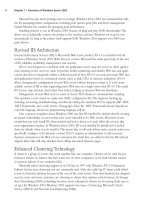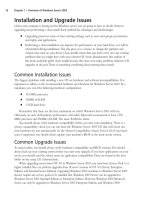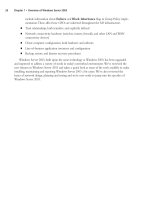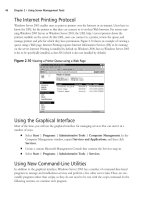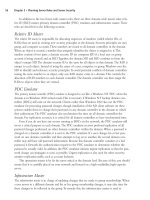The Best Damn Windows Server 2003 Book Period- P11 pptx
Bạn đang xem bản rút gọn của tài liệu. Xem và tải ngay bản đầy đủ của tài liệu tại đây (334.24 KB, 10 trang )
Terminal Servers
Terminal servers allow remote access to applications using thin-client technology.A benefit of
Terminal Services is that users can run programs that they might otherwise be unable to use. For
example, a user running an older version of Windows might need to use Office XP, but she doesn’t
have the minimal requirements install it.Through Terminal Services, she can connect to and be pre-
sented with a Windows Server 2003 desktop. If Office XP is installed on the terminal server, the
user can open and use the application. Because all processing occurs on the server, the user can run
applications that are impossible to install on her local system.
There are a wide variety of clients that can use Terminal Services. Client software is available for
Windows 3.11 and later, as well as Macintosh and UNIX. Internet Explorer can also be used to
access a terminal server, using the Web client software.Terminal Services can also interact with
Citrix clients.
Planning a Server Security Strategy
The only truly secure network is one that is totally inaccessible. Security is always a trade-off
between usability and protection. When planning security, you need to find an acceptable balance
between the need to secure your network and the need for users to be able to perform their jobs.
In creating a security plan, it is important to realize that the network environment will never be
completely secure.The goal is to make it difficult for intruders to obtain unauthorized access, so it
isn’t worth their time to try or continue attempting to gain access. It is also critical to protect servers
from potential disasters and to have methods to restore systems if they become compromised.
A good security plan considers the needs of a company and tries to balance it with their capabili-
ties and current technology.As you’ll see in the sections that follow, this means identifying the min-
imum security requirements for an organization, choosing an operating system, and identifying the
configurations necessary to meet these needs.To develop a security plan, you must identify the risks
that potentially threaten a network, determine what countermeasures are available to deal with them,
figure out what you can afford financially, and implement the countermeasures that are feasible.
Choosing the Operating System
In planning a strategy for server security, you will need to determine which operating systems will
be used in the organization. Different network operating systems provide diverse features that can be
used as part of your security strategy.
Of course, there are non-Microsoft network operating systems available to use on your server,
but we will consider only the following Windows server systems here:
■
Windows NT Server 4
■
Windows 2000 Server
■
Windows 2000 Advanced Server
■
Windows 2000 Datacenter
■
Windows Server 2003 Standard Edition
66 Chapter 3 • Planning Server Roles and Server Security
301_BD_w2k3_03.qxd 5/12/04 10:56 AM Page 66
■
Windows Server 2003 Enterprise Edition
■
Windows Server 2003 Datacenter Edition
■
Windows Server 2003 Web Edition
One of the first considerations for the operating system you choose will be the minimum
system requirements for installing the operating system. Obviously, if your existing server cannot
handle a particular version of Windows, you will not be able to install it. If this is the case, you will
need to upgrade the hardware, purchase a new server to support the operating system you want, or
choose an operating system that does match the current server’s hardware.The minimum system
requirements for Windows server operating systems are shown in Table 3.1.
Table 3.1 Minimum System Requirements for Windows Server Operating Systems
Computer/
Server Processor Memory (RAM) Hard Disk CPU Support
Windows NT 486/33 MHz or 16MB; 32MB Intel and Up to 4 CPUs
Server 4 higher/Pentium, recommended compatible systems: (retail version); Up
or Pentium 125MB available to 32 CPUs avail-
Pro processor hard disk space able from hard-
minimum. RISC- ware vendors
based systems: 1
60MB available
hard disk space
Windows 2000 133 MHz or At least 128MB: 2GB with 1GB free Up to 4 CPUs
Server higher Pentium- 256MB recom- space; additional
compatible CPU mended; 4GB free space required
maximum for installing over
a network
Windows 2000 133 MHz or At least 128MB; 2GB with 1GB free Up to 8 CPUs
Advanced Server higher Pentium- 256MB recom- space; additional
compatible CPU mended; 8GB free space required
maximum for installing over
a network
Windows 2000 Pentium III Xeon 256MB 2GB with 1GB free 8-way capable or
Datacenter processors or space; additional higher server (sup-
higher free space required ports up to
for installing over 32-way)
a network
Windows Server 133 MHz 128MB 1.5GB Up to 4 CPUs
2003 Standard
Edition
Windows Server 133 MHz for x86- 128MB 1.5GB for x86- Up to 8 CPUs
2003 Enterprise based computers; based computers;
Edition 733 MHz for 2GB for Itanium-
Itanium-based based computers
computers
Planning Server Roles and Server Security • Chapter 3 67
Continued
301_BD_w2k3_03.qxd 5/12/04 10:56 AM Page 67
Table 3.1 Minimum System Requirements for Windows Server Operating Systems
Computer/
Server Processor Memory (RAM) Hard Disk CPU Support
Windows Server 400 MHz for 512MB 1.5GB for x86- Minimum 8-way
2003 Datacenter x86-based based computers; capable machine
Edition computers; 2GB for Itanium- required;
733 MHz for based computers maximum 64
Itanium-based
computers
Windows Server
2003 Web Edition 133 MHz 128MB 1.5GB Up to 2 CPUs
Beyond the minimum requirements, you will need to look at the features available in different
versions and editions of Windows, and how they can be used to enhance network security.The pro-
gression from one version to another has offered improvements and additions to security, with
Windows Server 2003 offering the most security features. By identifying which features are necessary
for your organization, you can create a network that provides the necessary functionality and security.
Security Features
Windows 2000 offers a number of new security features that were not previously available in
Windows NT. Many of the features we’ll discuss next were implemented in Windows 2000 and
have been updated in Windows Server 2003. In addition, new features have been added that make
Windows Server 2003 the most secure Windows server product to date.The enhanced security fea-
tures were introduced in Chapter 1 and are discussed in greater detail throughout this book.
Identifying Minimum Security
Requirements for Your Organization
Before you can begin implementing security measures, you need to know what needs protecting.
For this reason, the security planning process involves considerable analysis.You need to determine
which risks could threaten a company, what impact these threats would have on the company, the
assets that the company needs to function, and what can be done to minimize or remove a potential
threat.
The following are the main types of threats:
■
Environmental threats, such as natural and man-made disasters
■
Deliberate threats, where a threat was intentionally caused
■
Accidental threats, where a threat was unintentionally caused
Environmental threats can be natural disasters, such as storms, floods, fires, earthquakes, torna-
does, and other acts of nature. When dealing with this type of disaster, it is important to analyze the
entire company’s risks, considering any branch offices located in different areas that may be prone to
different natural disasters.
68 Chapter 3 • Planning Server Roles and Server Security
301_BD_w2k3_03.qxd 5/12/04 10:56 AM Page 68
Human intervention can create problems as devastating as any natural disaster. Man-made disas-
ters can also occur when someone creates an event that has an adverse impact on the company’s
environment. For example, faulty wiring can cause a fire or power outage. In the same way, a com-
pany could be impacted by equipment failures, such as the air conditioning breaking down in the
server room, a critical system failing, or any number of other problems.
The deliberate threat type is one that results from malicious persons or programs, and they can
include potential risks such as hackers, viruses,Trojan horses, and various other attacks that can
damage data and equipment or disrupt services.This type of threat can also include disgruntled
employees who have authorized access to such assets and have the ability to harm the company
from within.
Many times, internal risks are not malicious in nature, but accidental. Employees can accidentally
delete a file, modify information with erroneous data, or make other mistakes that cause some form
of loss. Because people are fallible by nature, this type of risk is one of the most common.
Each business must identify the risks it may be in danger of confronting and determine what
assets will be affected by a potential problem, including:
■
Hardware Servers, workstations, hubs, printers, and other equipment.
■
Software Commercial software (off the shelf ) and in-house software.
■
Data Documents, databases, and other files needed by the business.
■
Personnel Employees who perform necessary tasks in the company.
■
Sundry equipment Office supplies, furniture, tools, and other assets needed for the busi-
ness to function properly.
■
Facilities The physical building and its components.
When identifying minimum security requirements, it is important to determine the value and
importance of assets, so you know which are vital to the company’s ability to function.You can then
prioritize risk, so that you can protect the most important assets of the company and implement
security measures to prevent or minimize potential threats.
Determining the value and importance of assets can be achieved in a number of ways. Keeping
an inventory of assets owned by the company will allow you to identify the equipment, software,
and other property owned by the company.
To determine the importance of data and other assets, and thereby determine what is vital to
secure, you can meet with department heads. Doing so will help you to identify the data and
resources that are necessary for people in each department to perform their jobs.
In addition to interviewing different members of an organization, review the corporate policies
for specifications of minimum security requirements. For example, a company may have a security
policy stating that all data is to be stored in specific folders on the server, and that the IT staff is
required to back up this data nightly. Such policies may not only provide insight on what is to be
protected, but also what procedures must be followed to provide this protection.
Companies may also be required to protect specific assets by law or to adhere to certain certifi-
cation standards. For example, hospitals are required to provide a reasonable level of security to pro-
tect patient records. If such requirements are not met, an organization can be subject to legal action.
Planning Server Roles and Server Security • Chapter 3 69
301_BD_w2k3_03.qxd 5/12/04 10:56 AM Page 69
Identifying Configurations
to Satisfy Security Requirements
To protect assets from risks that were identified as possible threats to a business, countermeasures
must be implemented. Servers will need certain configurations to provide security, and plans must
be put into practice. Compare the risks faced by an organization with an operating system’s features
to find support that will address certain threats. Configuring the server to use these services or tools
can assist in dealing with potential problems. For example, installing AD and using domain con-
trollers on a network can heighten security and provide the ability to control user access and secu-
rity across the network. In the same way, configuring a file server to use EFS so that data on the
server’s hard disk is encrypted can augment file security. Using security features in an operating
system allows you to minimize many potential threats.
The same technique should be used when determining which roles will be configured on
servers. As described earlier, different server roles provide different services to a network. By com-
paring the functionality of a server role to the needs of a company, you can identify which roles are
required. Although it may be tempting to configure a server with every possible role, this can cause
problems. When a server is configured to play a certain role in an organization, a number of dif-
ferent services, tools, and technologies may be installed and enabled. Never instal more roles than are
needed to provide required functionality. Always disable any unneeded services on the server.
Although roles are helpful, running a Wizard to configure servers in a particular role isn’t enough
to create a secure environment. Additional steps should be followed to protect these servers and the
data, applications, and other resources they provide. By customizing servers in this manner, you can
ensure that the company will be able to benefit from Windows Server 2003 without compromising
security. We’ll discuss these steps in the “Customizing Server Security” section later in this chapter.
Planning Baseline Security
Security templates allow you to apply security settings to machines.These templates provide a base-
line for analyzing security.Templates are .inf files that can be applied to computers manually or by
using Group Policy Objects (GPOs). Security templates are discussed in detail in Chapter
4“Security Templates and Software Updates.”
Customizing Server Security
Security templates contain predefined configurations, which are a great starting point, but usually,
they do not fulfill the needs of many organizations.You may need to make some changes to match
the organizational policies of your company. Similarly, configuring roles for servers requires addi-
tional steps to make the servers secure from attacks, accidents, and other possible problems. By cus-
tomizing server security, you can implement security measures that will fulfill the unique needs of
your organization.
70 Chapter 3 • Planning Server Roles and Server Security
301_BD_w2k3_03.qxd 5/12/04 10:56 AM Page 70
Securing Servers According to Server Roles
You can use the Configure Your Server Wizard to configure the server for a particular server role.
Though this procedure may install and enable a number of different services, tools, and technolo-
gies, additional steps usually are required to ensure the server’s security. Some tasks are unique to the
server’s role, but others should be applied to all servers on your network.
Security Issues Related to All Server Roles
Any server used by members of an organization might be at risk of attacks by hackers and malicious
programs, as well as accidents or other disasters.You will want to consider taking a number of coun-
termeasures to ensure that any server is well protected.
Physical Security
A large part of physical security involves protecting systems from unauthorized physical access. Even
if you’ve implemented strong security that prevents or limits access across a network, it will do little
good if a person can sit at the server and make changes or (even worse) pick up the server and walk
away with it If people do not have physical access to systems, the chances of unauthorized data
access are reduced.
Physical security also involves protecting servers and other assets from environmental disasters.
Uninterruptible Power Supplies (UPSs) should be installed to provide electricity during power out-
ages, and fire suppression systems to extinguish fires need to be in place (keep in mind that some
fire suppression systems are not suitable for server rooms because they can destroy the servers in the
process of extinguishing a fire). By considering natural risk sources within an area, you can deter-
mine which measures need to be taken to reduce or remove risks.
Physical security not only includes natural disasters, but also those caused by the workplace
environment. Servers need to be stored in stable areas that adhere to the environmental require-
ments of the equipment, which can include temperature and humidity specifications.
Service Packs and Hotfixes
At times, software vendors may release applications or operating systems with known vulnerabilities
or bugs, or these problems may be discovered after the software has been released. Service packs
contain updates that may improve the reliability, security, and software compatibility of a program or
operating system. Patches and bug fixes are used to repair errors in code or security issues. Failing to
install these may cause certain features to behave improperly, make improvements or new features
unavailable, or leave your system open to attacks from hackers or viruses. In most cases, the service
packs, patches, or bug fixes can be acquired from the manufacturer’s Web site.
Updates for Windows operating systems are made available on the Windows Update Web site,
which can be accessed through an Internet browser by visiting
Windows Update Web site determines what software is
recommended to secure your system, and then allows you to download and install it from the site.
Windows Update provides updates for only Windows operating systems, certain other Microsoft
software (such as Internet Explorer), and some additional third-party software, such as drivers.To
update most third-party programs installed on the computer, you will need to visit the manufac-
turer’s Web site, download the update, and then install it.
Planning Server Roles and Server Security • Chapter 3 71
301_BD_w2k3_03.qxd 5/12/04 10:56 AM Page 71
Windows 2000, Windows XP, and Windows Server 2003 also provide an automated update and
notification tool that allows critical updates to be downloaded and installed without user interven-
tion. When enabled, this tool regularly checks Microsoft’s Web site for updates, and if one or more
are found, automatically downloads and installs the update.You can also just have it notify you that
updates that are available. Because this tool requires connecting to Microsoft over the Internet, it can
be used only if the servers or workstations have Internet access.
In some situations, administrators may not want Windows Server 2003 to automatically download
and install software without their approval, or they may not want computers to connect to the
Microsoft Web site in this manner. In these cases, the Automatic Updates service should be disabled or
configured so that it is used for notification only.These settings can be accessed by selecting Start |
Control Panel | System and clicking the Automatic Updates tab in the System Properties
dialog box.As shown in Figure 3.11 the Automatic Updates tab provides a number of settings that
allow you to configure whether updates are automatically acquired and installed on the computer,
when updates occur, and whether intervention is required.These settings include the following:
■
Keep my computer up to date Enables Automatic Updates on the machine. When
this selected, the other settings in this list may be configured.
■
Notify me before downloading any updates and notify me again before
installing them on my computer Informs users that an update is available and asks
them if they would like to download it. If the user chooses to have the update down-
loaded, Automatic Updates will prompt the user when the download is complete, asking if
the update should be installed.
■
Download the updates automatically and notify me when they are ready to be
installed Causes any updates to be downloaded from the Microsoft Web site without any
notification. Once the update has completed downloading, the user is asked if the update
should be installed.
■
Automatically download the updates, and install them on the schedule that I
specify Causes any updates to be downloaded from the Microsoft Web site without any
notification. When this option is chosen, you can specify the time when the update can be
installed without user intervention.
72 Chapter 3 • Planning Server Roles and Server Security
301_BD_w2k3_03.qxd 5/12/04 10:56 AM Page 72
Antivirus Software
To prevent these malicious programs from causing problems, antivirus software should be installed
on servers and workstations throughout the network. Signature files are used to identify viruses and
let the software know how to remove them. Because new viruses appear every month, signature files
need to be updated regularly by downloading them from the vendor’s Web site.
Unnecessary Accounts and Services
Hackers and malicious programs can use insecure elements of a system to acquire greater access and
cause more damage.To keep these entities from exploiting elements of your system, you should dis-
able any services that are not needed. If a service has a weakness for which a security patch has not
been developed, it could be exploited. By disabling unneeded services, you are cutting off possible
avenues of attack. In doing so, you will not affect any functionality used by computers and users, and
you can avoid any security issues that may be related to them.
Certain accounts in Windows Server 2003 should also be disabled or deleted. If an account is
no longer being used, it should be removed to avoid a person or program using it to obtain unau-
thorized access. Even if an account will not be used temporarily (for example, during an employee’s
leave or vacation), the account should be disabled during the user’s absence. If an employee has left
permanently or a computer has been removed from the network, these accounts should be deleted.
Properly managing users and groups greatly simplifies this task and methods for doing so are dis-
cussed in detail in “Working with User, Group and Computer Accounts” later in this book.
There are other accounts that you should consider disabling due to their access level. Windows
Server 2003 and previous versions of Windows all have an account named Administrator that has
full rights on a server. Because hackers already know the username of this account, they only need
to obtain password to achieve this level of access. Although the Administrator account cannot be
deleted, it can be disabled and renamed. If you create new user accounts and add them to the
Administrators group, and disable the Administrator account, attackers will find it more difficult to
determine which account to target.
Planning Server Roles and Server Security • Chapter 3 73
Figure 3.11 Choosing Automatic Updates Options
301_BD_w2k3_03.qxd 5/12/04 10:56 AM Page 73
Another account that is disabled by default, and should remain so, is the Guest account.This
account is used to provide anonymous access to users who do not have their own account. Like the
Administrator account, the Guest account is created when Windows Server 2003 is installed.
Because there is the possibility that this account could accidentally be given improper levels of
access and could be exploited to gain even greater access, it is a good idea to leave this account dis-
abled. By giving users their own accounts, you can provide the access they need and audit their
actions when necessary.
For any user, group, or computer account, it is important to grant only the minimum level of
access needed.You want users to be unable to access anything beyond the scope of their role within
the organization.This will assist in keeping other data and systems on the network protected.
Determining what level of security a user needs to perform his or her job usually requires some
investigation. By understanding the job a user performs, you will be able to determine which
resources the user needs to access.
Strong Passwords
Strong passwords are more difficult to crack than simple ones.These types of passwords use a com-
bination of keyboard characters from each of the following categories:
■
Lowercase letters (a–z)
■
Uppercase letters (A–Z)
■
Numbers (0–9)
■
Special characters (` ~ ! @ # $ % ^ & * ( ) _ + - = { } | [ ] \ : “ ;‘ < > ? , . /)
The length of a password also affects how easy it is to crack.You can use security templates and
group policies to control how long a password is valid, the length of a password, and other aspects of
password management. Another requirement that is important to having secure passwords is making
sure that each time users change their passwords, they use passwords that are different from previous
passwords.
To ensure domain controllers are secure, there are a number of password requirements that are
enforced by default on Windows 2003 domain controllers:
■
The password cannot contain any part of the user’s account name.
■
It must be a minimum of six characters in length.
■
It must contain characters from three of the four categories: lowercase letters, uppercase
letters, numbers, and special characters.
NTFS
Windows Server 2003 supports the FAT, FAT32, and NTFS file systems. Of these, NTFS pro-
vides the highest level of security. Disk partitions can be formatted with NTFS when a server is ini-
tially installed. If a volume is formatted as FAT or FAT32, you can convert it to NTFS.You can
convert partitions to NTFS by using the command-line tool convert.exe.
74 Chapter 3 • Planning Server Roles and Server Security
301_BD_w2k3_03.qxd 5/12/04 10:56 AM Page 74
Regular Backups
It is also important to perform regular data backups. Windows Server 2003 also provides Automated
System Recovery and the Recovery Console for restoring systems that have failed.
Recovery Console is a text-mode command interpreter that can be used without starting
Windows Server 2003. It allows you to access the hard disk and use commands to troubleshoot and
manage problems that prevent the operating system from starting properly.
Automated System Recovery (ASR) allows you to back up and restore the Registry, boot files, and
other system state data, as well as other data used by the operating system. An ASR set consists of
files that are needed to restore Windows Server 2003 if the system cannot be started. In addition,
ASR creates a floppy disk that contains system settings. Because an ASR set focuses on the files
needed to restore the system, data files are not included in the backup.You should create an ASR set
each time a major hardware change or a change to the operating system is made on the computer
running Windows Server 2003. ASR should not be used as the first step in recovering an operating
system. In fact, Microsoft recommends that it be the last possible option for system recovery and be
used only after you’ve attempted other methods. In many cases, you’ll be able to get back into the
system using Safe Mode, the Last Known Good Configuration or other options.
To create an ASR set, use the Windows Server 2003 Backup utility. On the Welcome tab of
the Backup utility, click the Automated System Recovery Wizard button.This starts the
Automated System Recovery Preparation Wizard, which takes you through the steps of
backing up the system files needed to recover Windows Server 2003 and creating a floppy disk con-
taining the information needed to restore the system.
Securing Domain Controllers
The methods described in the previous sections can improve the security of a server in any role, but
they are particularly important for domain controllers.The effects of an unsecured domain controller
can be far-reaching. Information in AD is replicated to other domain controllers, so changes on one
domain controller can affect all of them.This means that if an unauthorized entity accessed the direc-
tory and made changes, every domain controller would be updated with these changes.This includes
disabled or deleted accounts, modifications to groups, and changes to other objects in the directory.
Because all Windows 2000 Server domain controllers store a writable copy of AD (unlike Windows
Server 2003), additional steps must be taken to secure the directory in a mixed environment.
It is important that group membership is controlled, so that the likelihood of accidental or mali-
cious changes being made to AD is minimized.This especially applies to the Enterprise Admins,
Domain Admins, Account Operators, Server Operators, and Administrators groups.
Because anyone who has physical access to the domain controller can make changes to the
domain controller and AD, it is important that these servers have heightened security. Consider using
smart cards to control authentication at the server console.
Encryption should also be used to protect data and authenticate users. As mentioned, NTFS
partitions allow file encryption, and Kerberos provides strong authentication security. In Windows
Server 2003, Kerberos is the default authentication protocol for domain members running Windows
2000 or later.
Planning Server Roles and Server Security • Chapter 3 75
301_BD_w2k3_03.qxd 5/12/04 10:56 AM Page 75




